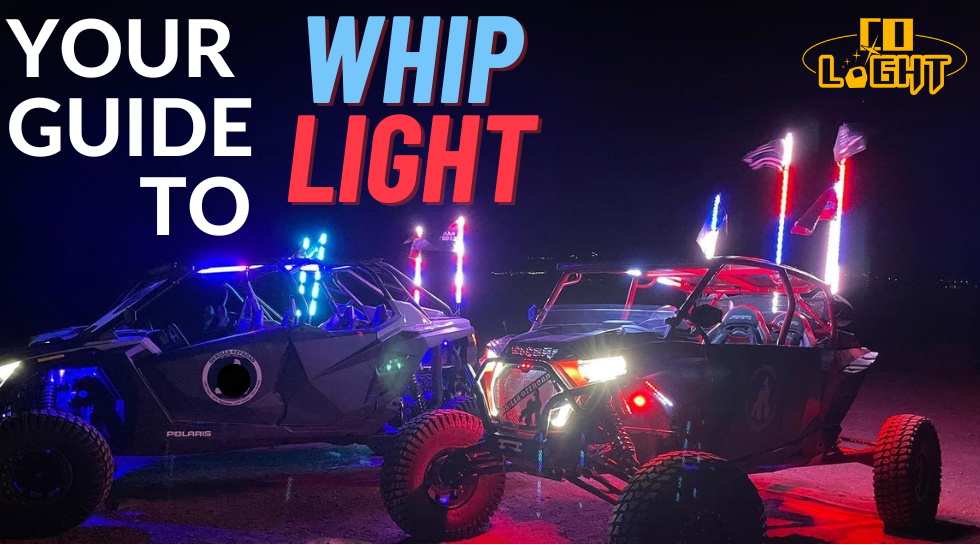What is whip light?
"Whip light" is an excellent choice for the unique interior design of your UTV or Jeep. Other motorcyclists will find it easier to locate your vehicle.Thanks to the vibrant and bright RGB lights, LED whip lights generate color-changing illumination in the dark, making them helpful. You can easily control the color of the lights through a Bluetooth application and radio frequency remote control.These lights are referred to as "whip lights" rather than the typical light strips. This is especially useful in conditions of low visibility or when you want to make your vehicle more conspicuous. It features customizable RGB+W color functionality, allowing you to personalize your off-road vehicle and make it stand out in a crowd.Whip lights come in both flexible and non-flexible varieties, with the non-flexible type being adjustable for curvature by adding a spring base.If you own them, they will not only add elegance but also safety to your off-road vehicle.
Hope this article can help you understand what is whip light, where to mount your whip light, and how to choose the length for whip lights.
What is the purpose of whip lights on a UTV?
Whip lights on a UTV (Utility Task Vehicle) serve five fundamental purposes that enhance the overall riding experience.
- They make the UTV more conspicuous to other riders, especially in hilly or rugged terrains, helping prevent collisions and increasing safety.
- In certain areas, whip lights are required to comply with local regulations.
- Whip lights provide additional illumination for nighttime riding, making navigation and obstacle observation easier in low-light conditions.
- During emergencies or breakdowns, whip lights can serve as safety signals, attracting the attention of other riders or rescue teams.
- Whip lights offer features like color-changing and brightness adjustment, adding fun to the riding experience. They can also help mark paths or routes, providing guidance to other riders in the group, especially in complex or unfamiliar terrains.
Where to Mount Your Whip Light: Finding the Perfect Spot
When it comes to mounting a whip light, the rear of the vehicle is often the preferred location. You want to ensure that the whip light is not in the way of the bed function or too close to the cab. Here are some considerations:
- Top of the Sides of the Bed: This allows the whip light to be at the back of the machine but not in the way of the bed at all.
- C-Pillar: If you locate it high enough, a bed tilt should function.
- Front Bed Pocket: Using an expanding type sleeve to anchor it down, then a 4″ offset forward mounting the whip at a 45-degree angle backward, keeps the tips at roof level.
Generally, whip lights are mounted on the rear of the UTV, usually attached to the roll cage or frame, to provide maximum visibility without obstructing the driver's view.
Notes:
- Ensure secure installation to prevent detachment.
- Adjust brightness appropriately to avoid blinding oncoming riders.
- Comply with local regulations and laws regarding the use of whip lights.
- Choose an appropriate length to prevent contact with obstacles, branches, or other objects while riding.
How to choose the length of whip light
1FT:
- Compact size, convenient installation, flexible positioning.
- Suitable for installation on various vehicle models.
- Low energy consumption, suitable for outdoor off-roading.
- Recommended for installation on UTV rooftops.
2FT:
- More visually appealing.
- Moderate length to meet different lighting needs.
- Illuminates a larger area, providing relatively even lighting effects.
- Suitable for installation around the vehicle.
3FT:
- Suitable for outdoor off-roading, captures attention from others.
- Longer length, better suited for adventurous needs.
Based on the above features, you can choose the desired length. If your budget is limited, you can opt for 1FT/2FT; if you enjoy riding on sand dunes at night or outdoor adventures, 3FT is the optimal choice.
F&Q
Are whip lights worth buying?
Yes, UTV enthusiasts generally consider whip lights to be a worthwhile investment. They enhance safety by increasing visibility, especially in challenging terrains and low-light conditions. In regulated areas, whip lights also help with legal compliance. Beyond functionality, whip lights add aesthetics to the vehicle, achieving a customized and distinctive appearance. Whether for safety, compliance, or style considerations, whip lights provide significant value for many riders.
Can whip lights be used for off-road events?
Yes, whip lights are popular choices for off-road events, gatherings, and competitions. They add a festive and distinctive atmosphere, making vehicles stand out in a crowd.
Are whip lights legal?
The legality of whip lights varies by region. In some areas, they might be required to meet specific regulations, such as color, brightness, or usage restrictions. It's important to check local laws before installing whip lights.
Can whip lights be used for emergency situations?
Yes, whip lights can serve as safety signals during emergencies or breakdowns. Their bright and noticeable illumination can attract attention, aiding rescue efforts or alerting other riders.
Can whip lights withstand rough off-road conditions?
Many whip lights are designed to be durable and water-resistant, making them suitable for off-road use. However, it's important to choose high-quality lights and ensure proper installation to withstand rough conditions.
Do whip lights drain the vehicle's battery?
Whip lights do consume energy, but their impact on the battery depends on factors like usage duration and the vehicle's electrical capacity. It's a good practice to turn them off when not needed to conserve battery power.
Hope the above information helps you get a better understanding of Whip Light and assists you in making the right decision. If you have any questions, welcome to ask COLIGHT!



